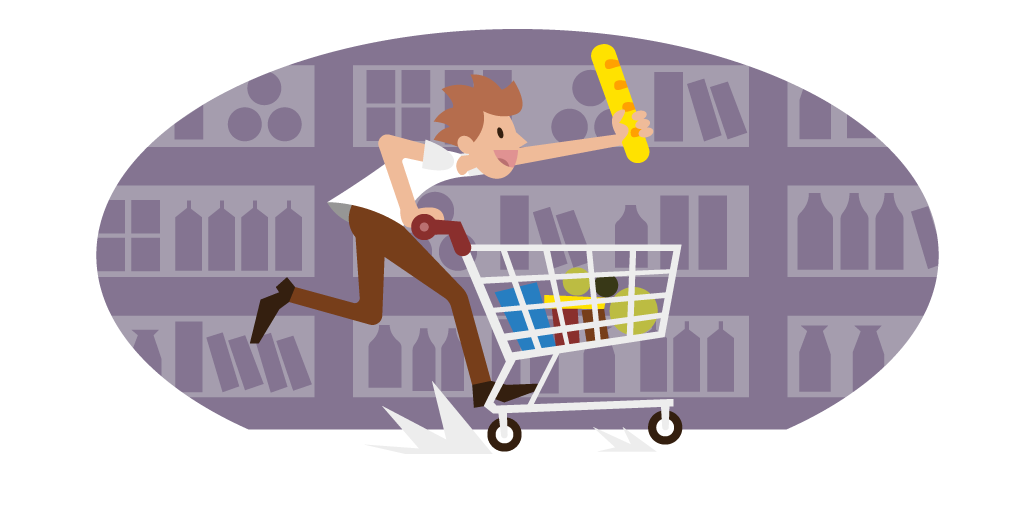A study about consumer buying behavior found that 45% of customers found waiting in line “very irritating”. Well, no surprise there.
Nothing scares away customers more than a long waiting line. If you go to the grocery store for a carton of milk and the line curves outside the door, do you really look forward to waiting?
We all know what it's like to impatiently check the time while we wait in line. But, maybe there’s a way to make the customer experience less irritating?
Ever since MIT professor Richard Larson published “The Psychology of Queuing and Social Justice” there has been a recognized science of queuing theory.
Four decades of research can help us in understanding consumer behavior to build a better queuing theory.
Jockeying in Queuing Theory
What is jockeying?
If you’ve ever been stuck in traffic, you’re already acquainted with a perfect analogy for jockeying in queuing theory. Annoyed drivers zip back and forth between lanes in a desperate attempt to crawl faster than the cars next to them.
And often, they choose wrong.
In the same vein, consumer habits dictate that customers want to get to the register fast. If we see another lane moving quicker than our own, we rationalize that it's faster to jump ship and try your luck on the next lane.
This line-jumping is called jockeying behavior.
Models of consumer behavior show exactly why this happens. Think of the statistics. With one in four lines, you have a 25% chance of being in the fastest lane.
In all likelihood, another lane is moving faster than yours.
The Hamletian question of “to hop lines, or not to hop lines” actually has a definitive answer. Jockeying not only leads to customers becoming annoyed when they choose poorly, but it also slows down the overall efficiency of queues.
So why not remove the question altogether?
A Serpentine Solution to Queuing Problem

One long snaking line — called a serpentine line — is the most efficient customer queuing system.
If one register is stuck waiting for management to confirm a price check, customers aren’t forced to wait longer. They simply move to the next available register when it’s their turn.
Serpentine lines also promote fairness — what may be the root of our sense of justice. In a serpentine line, nobody who arrives after you will ever be served before you.
The law of first come, first serve is in full force.
Unfortunately, there’s a reason why more companies don’t use single lanes to prevent jockeying in queuing theory. The psychology of queuing tells us why.
Many customers look at one long snaking line and think, “Thanks, but no thanks!” A serpentine line looks too long and appears to be moving too slow.
Consumer habits are influenced by perceptual biases that get in the way of efficiency and persuade them to test their luck gambling.
The question is, how do you prevent people’s perceptions from getting the better of them?
Balking in Queuing Theory
Balking in queuing theory is when customers look at a waiting line and decide it’s not worth their time to queue up and wait.
Unlike queuing in amusement parks, queuing in stores isn’t promising a thrill for patience. And, in contrast with hospitals, stores don’t deal with life-or-death situations, so there’s always an alternative.
So how do you deal with balking? To prevent customers from leaving, businesses have to persuade them to wait.
Luckily, thanks to researchers studying queuing theory, there are a number of solutions to balking.
Display the Wait Time to Prevent Customers From Leaving

The uncertainty of how long a line will take is a killer.
It’s typical of customer habits to see one long line and start calculating under the assumption that length is equal to time. It’s a natural thing and a major cause of balking in queuing theory.
According to research on customer buying behavior, people overestimate their wait time by around 36%. We have a perceptual knack to inflate our suffering.
Customers have to be persuaded to wait, lest their imaginations send them to the parking lot.
What’s the solution? Display the wait time.
A simple counter telling customers how long exactly they have to wait anchors a customer’s patience. The customer who would normally balk at a single-long line decides to wait, since the counter reads it will only take five minutes to checkout.
In the words of David H. Maister:
“Waiting in ignorance creates a feeling of powerlessness, which frequently results in visible irritation and rudeness on the part of customers.”
People not only fear the unknown — they can also get annoyed by it.
Sign-In to Wait on Line
Why not trade in physical lines for a virtual queuing system? A queue management system can replace lines and prevent balking in queuing theory altogether.
Set up tablets throughout your store to allow customers to reserve their spot in line. When it’s their turn, simply call them to the front for check out.
Customers feel empowered and can distract themselves by examining items — possibly leading to an additional impulse purchase.
A queue management system also personalizes the experience. Instead of having customers pull a number and waiting for their number to be called, a worker calls out their name.
In case you’ve missed us telling this before: Nothing is more personal than hearing our names.
Reneging in Queuing Theory

“Reneging” is so bad of a behavior, it even sounds dangerous. As if your customers become renegades.
In truth, reneging may be even worse than balking. It’s when a customer has joined the line but decides they don’t want to wait.
So what do they do? Consumer habits dictate that they renege — they simply walk out the door.
Reneging in queuing theory signals that a customer came in committed to make a purchase. But then they weigh their time versus their desire for the item, and the scale tips towards “I’m out of here”.
One mistake, and your customers are leaving for your competitors.
As essayist Lance Morrow put it:
“Waiting can seem an interval of non-being, the black space between events and the outcomes of desires. It makes time maddeningly elastic, it has a way of seeming to compact eternity into a few hours.”
While waiting in line doesn’t necessarily invoke the same melodrama, the sentiment is certainly fitting. Models of consumer behavior show that customers don’t want to waste their time.
What can be done to fix that?
Entertain Your Customers
Seattle band Nirvana unwittingly described the behavior of most customers when they sang “Here we are now, entertain us!”
The point is, keep your customers distracted from waiting. Any method is fine, even installing new TVs in your location.
In a study by Millward Brown examining models of consumer behavior, 84% of grocery store shoppers reported that watching digital signs made checking out far less daunting.
In addition, over 70% of surveyed customers said they would watch screens, while 15.7% were unsure.
That’s a potentially whopping number of people who would be entertained while waiting in line. Further evidence suggests that nearly half of customers are more willing to shop at stores with screens.
As David Maister writes, "Occupied time feels shorter than unoccupied time". Sounds obvious?
Because it really is.
Further evidence suggests that perceived wait time is reduced as much as 35% by digital signs. Also, seven in ten customers make a purchase because something caught their eye from a digital sign.
Businesses don’t have to employ televisions to overcome reneging in queuing theory. You’re free to get creative.
For example, Atlanta International Airport hired a violinist to play while people waited to be patted down by the TSA. Not only did the soothing sounds ease customer’s anxiety but it turned customer’s attention away from the anxiety of metal detectors to the sound of Bach.
Turn to customer feedback to understand how to build this superior customer experience.
Collect Customer Analytics

While we’ve discussed customer queuing systems to improve customers’ time waiting, there’s an additional overlooked component of queuing theory.
Exceptional customer service can override waiting times. 91% of Americans report that customer service dictates who will receive their business.
Learn who your customers are. Hointer’s Seattle store collects analytics on customer buying behavior, to learn which customers like being helped by a service representative and which like to be left alone.
More than just developing models of consumer behavior, it’s a measure of how sales representatives are to communicate with customers. In turn, it teaches customers what kind of shopping experience they can expect by visiting the store.
Relaxed customers who receive a service they need are less likely to balk, renege, or jockey on lines. They’re more likely to continue visiting the store, effectively becoming your loyal customers.
It’s a win-win situation that increases customer retention and meets the recommendations of queuing theory.
Applying the latest research in queuing theory helps businesses keep customers happy, to improve the customer’s experience, and improve business. What’s not to like?
But it requires businesses to understand the psychology of queuing and empathize with their customers. The question all businesses need to ask is, “What would make my experience waiting in queue better?”
Because understanding consumer behavior and the hurdles posed by customer queuing systems improves the shopping experience for everyone.
Now that we're done with queuing theory, it's time for queuing practice!
Try out a free 14-day Qminder trial to apply your new knowledge for a better customer experience!






